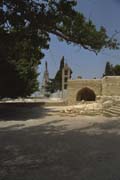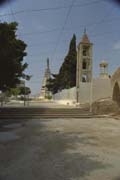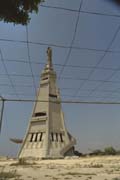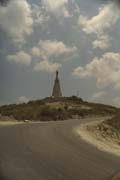
Did Christ Visit Maghdouche's al-Mantara Cave Chapel?
Bruce Condè, 1955 and 1960
|

The modern tower of the Saydi from the road approaching Maghdouche. © Børre Ludvigsen, 1995
|
Helena-Empress-Mother of the Romans, leaned forward with
quickening interest as her son's humble Sidonian subject, looking
straight into her eyes, told his guileless tale of Jesus' visit to
Sidon.
"And when Our Lord had finished teaching the multitude in
Sidon. He ascended the mountain to rejoin His Mother, who was
waiting"
"Go on," said the Empress, gently.
"And after resting there for the night, the Holy Personages
returned on the morrow to Galilee. Thus spoke our fathers and our
fathers' fathers, admonishing us always to hold sacred that spot."
"Thank you, my son. You have come a long way to bring us
this news which we sought. Await us without, and we shall give our
answer to your elders."
The Phoenician peasant kissed his Empress' extended hand and
withdrew in awe.
"It is preposterous, Your Majesty", cried the Keeper of the Privy
Purse. "If you continue to listen to everyone who comes to you from
the Holy Land and to endow every spot for which they advance any kind
of fantastic claim, the treasury will soon be bankrupt. All students
of the holy writings know that Our Lord's mission was in Galilee
and Judea, not in Pheonicia."
"Patience, patience. It was I who sent for this man, on hearing from
the superintendent in charge of building the nearby, signal fire tower
that the simple Christian folk of Maghdoushe village so venerated this
spot. Do you see any guile in this man? When the village elders heard
why I had sent for him, they asked that I join them in convincing
their Bishop that a little chapel should be consecrated at this
holiest place in Phoenicia. That is why I have summoned our Lord
Bishop of Tyre." She motioned to a chamberlain who conducted the
Tyrian prelate to the council chamber.
|

The building outside the cave. © Børre Ludvigsen, 1995
|
Scriptural Proof
"What is your opinion of this matter, good Father" asked the
Empress, after explaining the villagers' tradition to him.
"It is possible, Your Majesty, that the references which St. Mark
makes in III, 8 and VII, 24-31, could be interpreted to mean that Our
Lord's mission in Upper Galilee also extended to the southern cities
of Phoenicia, within our own see of Tyre and Sidon. Thus far, no
miracle has ever been reported at this spot, and we have no records,
other than verbal tradition, to indicate its holiness, only.. "
"Only what, good Father ?"
"Your Majesty, these are good and honest folk. They have no doubt
been Christians since the time ol Our Lord, or certainly since St.
Paul's ministry among them. They keep faith with God and with man.
There is no reason why they should try to deceive us in this matter,
and our Holy Mother the Church teaches us that sacred tradition can
have the weight of scripture in certain cases. They ask for nothing
but that I consecrate tne spot for holy worship, to keep faith with
their fathers' pious tradition. They ask for no church, only for the
blessing of the cave as a little chapel in honor of the visit of the
Holy Family. Till now I have hesitated, doubting my capacity to so
judge tradition, and for want of records or of a miraculous happening,
but... "
"But if we endow a little chapel there, and provide it with
a suitable ikon, what harm is done ? If miracles be needed, God
will provide them in His good time ".
"Then Your Majesty will sponsor this undertaking ? "
"It is our wish. Let us summon the villager and give him
our answer ".
|

The cave interior with the ikon on the far wall. © Børre Ludvigsen, 1995
|
Empress Orders Shrine
When the Sidonian stood before her, the Empress spoke to him softly.
"Our good Bishop has consented to consecrate the holy place, and we
shall send you an ikon and some altar furnish- ings for the new
chapel, in token of our esteem. What ao your people call the spot
today ?"
"We call it the "Place of the Awaiting", Great Lady, for it
was there that Our Blessed Mother awaited her Son ", answered
the peasant.
" Good. Do you, Lord Bishop, consecrate it to " Our Lady of the
Awaiting", and we shall provide for it a likeness of the blessed
Mother, and other suitable objects, and the wherewithal to provide
lamps and oil, and other necessities, that our own faith be not less
than that of our good villagers of Maghdoushe".
And so it was.
At a date which could not be far from the year 326, the Empress Helena
forwarded to the religious authorities of the province of Phoenicia
Prima, an ikon of the Virgin and Child, which, like so many other holy
pictures known to have been the gifts of Byzantine royalty, eventually
came to be regarded as miraculous, and was said to have been painted
by the hand of St. Luke himself. Funds were provided from the
imperial purse for the upkeep of the chapel during the remaining three
centuries of Byzantine rule in Phoenicia. The little shrine was known
and visited by the Phoenician Christians, but being overshadowed by
the proximity of the major Holy Places in Palestine, does not seem to
have attracted foreign pilgrims or undue fame.
|

The area outside the cave with the modern tower with the statue of the Saidy. © Børre Ludvigsen, 1995
|
Heraclius' Farewell
In 636, Phcenicia's last Byzantine sovereign, Emperor
Heraclius, recoverer of the True Cross from the Persians, was
decisively beaten at the Battle of the Yarmuk by Arab Generalissimo
Khalid ibn al-Walid.
"Farewell, O Syria, and what an excellent land thou art for
the enemy !" exclaimed the Basilios, on being forced to abandon
the eastern provinces of his empire to the Caliph. The latter,
Omar, a pious and humble man, spared Christendom's holiest
shrines, in Jerusalem and elsewhere, and showed an inclination
toward tolerance in dealing with his new Christian subjects.
Alas, it was not so with Phoenicia, Prima. Less tolerant
administrators laid heavy hands on the Christian maritime cities of
Tyre, Sidon, Beirut, Byblos, Tripoli, Latakia and even holy
Antioch, where the very name "Christian" had first been used.
A hard decision now lay before the elders of Maghdoushe.
"It is not that we object to being the Arab caliph's subjects", they
reasoned, "for our fathers had begun to speak Arabic and to adopt Arab
customs long before ibn al-Walid's Moslem armies swept over our land.
But our faith will be cha]lenged if we remain here in the foothills of
Sidon. Already most of the Sidonians have become Moslems, to enjoy
privileges and immunities. They will tempt our sons and daughters".
|

The modern tower of the Saidy, built in the late 1960's and damaged during the war between Israel and the PLO in 1982.
© Børre Ludvigsen, 1995
|
Exodus to Zahle
The younger men argued that the hills and valleys of Sidon were rich
and fruitful. To withdraw into the inhospitable fastnesses of Mount
Lebanon, to abandon their sacred shrine, where the Holy Family had
honored their village alone of all Phoenicia would be cowardice. The
chapel itself would be their talisman and safeguard.
"Nay. These are evil days. There will come fanatics who will seek out
our holiest shrines to destroy them. The good Omar spared Jerusalem,
but those who followed him grow more bold and arrogant daily, and only
God knows what may some day happen to the Holy Sepulchre itself. It is
best that we conceal the place of Our Lady in Maghdoushe and go to the
land of Christians, in the interior, keeping the secret and our faith
in our hearts until we return here in better days".
According to the patriarchal custom of the Arabs and of Mount Lebanon,
the will of the elders prevailed. Carefully they concealed the
entrance to the ancient grotto with stones, earth and vines. Little
by little they sent their herds and most prescious possessions back
through obscure mountain paths to the strongholds of Christian
Lebanon. When the decided-upon day arrived, the entire populace fled
en-masse to the towns of Zahle and Zouk, from whose secure heights
strong Christian bands were successfully maintaining themselves.
Eventually the caliphal governors, wearying, of incessant and
fruitless punitive expeditions. advised the imperial court in Damascus
that the best way to control these stubborn "People of the Book" would
be to recognize them as autonomous communities, paying a fixed tax,
under their own religious leaders. It was thus that the Maronite
Patriarch of Antioch and of all the Orient became a virtual
Prince-Bishop of Mount Lebanon. The Greek Catholic followers of the
Byzantine rite, to which the Maghdoushe villagers adhered, were placed
beneath the rule of their owm metropolitans and of the Melkite
Patriarch of Antioch. As long as they stayed in their new mountain
retreats they were unmolested, but return to Maghdoushe they dared
not.
The legend of Sayidet al-Mantara ‹ as Our Lady of the Awaiting is
called in Arabic ‹ continued to be passed down among the exiled
Maghdoushians for the next thousand years. It grew dim, but it
persisted.
The community could have returned in Crusader times, some
half-thousand years later, save for a new factor. The Crusaders, it so
happened, were all of the Latin rite, and although the Maronites and
many of the Greek Catholics were also in communion with Rome, they
clung to their Oriental usage and to their Syriac and Greek liturgies,
refusing to subordinate themselves to the Latin customs of the Franks,
which the latter tried to impose throughout their dominions. For their
part, the Crusaders of Sidon, or La Sagette, as they called it, spent
most of the 12th and 13th Centuries in the shadow of al-Mantara
without ever suspecting the grotto chapel's existence. In fact, they
built a small castle, called La Franche Garde, on top of the ruins of
Empress Helena's tower, within a stone's throw of the hidden entrance
to the cave, without ever finding it.
|

The view south from Magdouche. © Børre Ludvigsen, 1995
|
Return Under Fakhreddin
Rediscovery of al-Mantara had to await the reign of Lebanon's greatest
ruler of all times, the Druze prince, Fakhreddin II "the Great"
(1572-1635), in the early 17th Century. The diminutive mountaineer,
paramount prince of the followers of a secret Oriental religion which
believes in strict unitarianism and in the transmigration of souls,
was perhaps the most tolerant and enlightened Arab ruler of his day
and age. With a Christian (Maronite) Prime Minister, a Moslem Minister
of the Interior, a Druze army commander and a Jewish Finance Minister,
it was not surprising that his non-sectarian state, where all
religions flourished under the princely patronage, soon became the
most contented and prosperous principality in the Ottoman empire.
Openly making treaties with Tuscany, other Italian states, Spain and
France, opening his ports to foreign trade, welcoming Jesuit
missionaries to open educational missions in Mount Lebanon, Fakhreddin
the Great created, for the first time in a thousand years, the
conditions of freedom and security which alone could induce
Maghdoushe's sons to return to their ancestral home.
Again the elders announced their decision. Again the young
men drove the flocks and herds over mountain trails back to the
pleasant rolling hilltops above Sidon.
But they could not locate Sayidet al-Mantara, now only a dim,
half-forgotten tradition, even though for years they worked almost
daily within a few yards of the hidden grotto, as they pulled down La
Franche Garde, stone by stone, for building material for their new
homes.
|

View of Saida from Magdhouche, with the Ain el Helwe refugee camp in the foreground. © Børre Ludvigsen, 1995
|
Rediscovered by Lad
One day, as a village lad was tending his goats in a bramble thicket
near the ruined castle, one of the kids fell down a chimney-like
opening in the porous limestone rocks typical of Mount Lebanon. He
could hear the little goat bleating, still alive, in some recess, far
below. Good goatherd that he was, the boy made a rope of vines, tied
it to a small tree, and descended, somewhat fearfully, into the black
depths. Just before he reached the spot where the goat was, his rope
broker and he tumbled onto a flat rock floor, but the little goat
scrambled happily into his arms. When his eyes became accustomed to
the gloom, the lad was startled to see before him what appeared to be
a rock-cut altar, from whose niche came the faint glow of a golden
object Approaching it, the boy saw that it was a holy ikon. Without
touching it, he piled some nearby stones on the floor beneath the hole
through which he had fallen, and worked his way back up the fissure,
the little kid securely tied into his clothing. Running to the
village, he told the people of his discovery.
The next day a man was let down into the cave with a torch. He found
tha walled-up entranceway and led a party to open it. The elders
solemnly assured the younger generation that this was indeed the holy
spot of their ancestors, whose memory had been one of the community's
strong,est bonds of solidarity while they were in exile.
"The ikon is ours, given to us by Saint Helena. Let us enshrine it in
our new church", they said, sending a courier to the Bishop of Sidon
to advise the prelate of the momentous discovery. The holy picture
was carried with reverence to the towering new church of Crusader
masonry in the center of the town and placed on the sanctuary screen.
But when the Bishop arrived, a day later, the ikon was missing from
the church. Nevertheless, His Excellency went to see the holy cave.
There, on the rock-cut altar, was the ikon !
"Strange," said the Bishop, "but take it back to the church."
That night they put a guard around the church, but in the morning the
ikon was back in the cave.
|

© Børre Ludvigsen, 1995
|
The Reluctant Ikon
"Enough", observed His Excellency, "it is clear that Our Lady does not
wish the holy ikon to leave the grotto. According to tradition, the
cave has already been dedicated as a place of worship, and this is
substantiated by the altar-stone. Therefore, we hereby rededicate it
as the Church of Sayidet al-Mantara and we order that the ikon remain
perpetually on its altar."
And thus it remains today. A few pointed masonry arches were later
built as a simple porch for the church, whose main room is the chapel,
with the contiguous grotto chambers used for storage. The adjacent
hilltop has now been converted into Sidon's Greek Catholic cemetery,
where Catholic Sidonians, and others of their rite throughout Lebanon,
may be buried near the spot where they believe that Jesus and Mary
once stood, looking down upon Phoenicia's Queen of Clities, in the
early days of the Roman empire.
The ikon itself, which has never left the sanctuary since the 17th
Century, is faded and worn, with metallic haloes of gold and with
silver hands affixed to the wood over their painted sors. A leg of the
Child, also of silver, has been misplaced too far to the left, and the
entire picture is now encased in glass and almost impossible to
photograph satisfactorily. Under the circumstances, the painting has
never been studied thoroughly by competent experts, but those who have
examined it superficially agree that it seems to be of the early
Byzantine type, if not older. The metallic additions are modern, not
antedating the 17th Century.
|
|
|
Crusader Ruins Buried
On the point of the hill, where the shell of a World War II guard post
obscures the site of the castle's ruins, visitors now go to get a
sweeping panorama view of Sidon. During the late Ottoman period,
workmen discovered the door to an underground vault of the castle, but
the village priest, on instructions from his bishop, ordered it sealed
and reburied for fear that a Turkish expedition might come looking for
treasure, with dire results for both Sayidet al-Mantara and the
villagers of Maghdoushe.
Renan, in 1860, found one course of masonry still above the ground,
but today ever, that has disappeared. There are traces, however, of
the rock-cut stairway, 100 yards long and three to four in with that
ran up the hill from the west to an esplanade in front of (south of)
the castle, although the modern highway now cuts through a large
section of this grand staircase.
To reach al-Mantara one may take a "service" taxi near the south end
of Sidon's main street (for 50 piasters, to Maghdoushe) asking to be
let out at Sayidet al-Mantara, or, if driving, follow the coast
highway about 4 kilometers south (across the river Saitaniq), turning
left, (inland) on the branch paved road for an additional three
kilometers or so.
From See Lebanon, Bruce Condè, second edition, Harb Bijjani Press, Beirut, 1960
|

